Water Rising
By John Palka — Posted February 21, 2016
The majesty of the great trees of the North American coastal rainforest is awe-inspiring. Many a visitor is drawn to touch the massive trunks, sensing that this brings contact with life. My own experience is that my connection with living beings feels even stronger when I visualize some of the life processes that are going on inside them, underneath the surface that I can see. Let me guide you inside a tree to explore one such life-sustaining process, the movement of the water that is necessary for photosynthesis and, indeed, for life itself.
Water enters a plant, including any tree, not through its leaves but through its roots. This fact immediately presents us with a conundrum—all of the plant’s living cells require water, so this vital substance must be distributed throughout the plant from the point where it enters, at the roots. What’s more, the plant’s fundamental process of photosynthesis, which requires water, takes place not in the roots or stems, but in the leaves. The leaves (or in conifers, the needles) can be in a canopy that is easily 200, and sometimes more than 300, feet above the ground. Here is a view of the canopy of the Wind River Experimental Forest, an old-growth forest in the Washington Cascades. It was taken from a special-purpose crane rising even higher than the trees, so that we could look down on them from a gondola. From this perspective, it’s 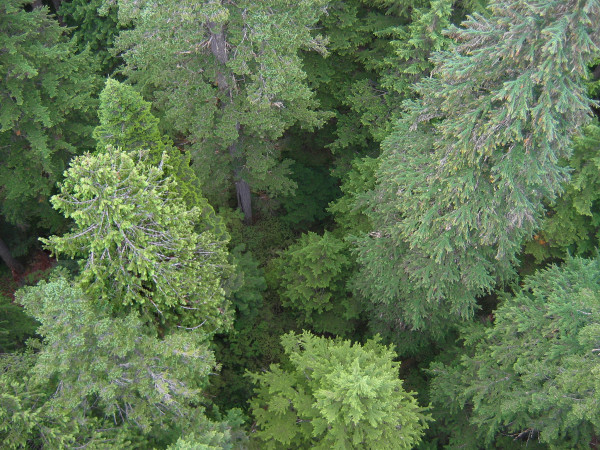
easy to see that delivering the water needed for life and for photosynthesis to leaves or needles so high off the ground is an enormous challenge. How is it even possible? How do you move water twenty-plus stories into the air without even having a pump?
The first clue comes from the structure of wood. We can get a hint of this structure by examining a common sight in Northwestern forests, the cut surface of a tree that has fallen to the forest floor and blocked a trail. Here is an example: a young Douglas fir that fell in the woods near our home and was cut into rounds by a neighbor who maintains the trail for the public. It
is lying next to a red alder that met a similar fate. The cut surface shows us the tree’s older, darker wood (the heartwood) in the center; the younger, lighter wood (the sapwood) around it; and the growth rings that allow us to determine exactly how old the tree was when it fell. All the wood we see—heartwood, sapwood, rings—is made of elongated cells that secrete around themselves stiff walls built primarily of the complex molecules cellulose and lignin. These molecules are what makes wood tough. Remarkably, however, most of the cells soon die, leaving behind only their walls—stiff, hollow cylinders.
So, wood is made up primarily of dead cells, but in death these cells serve an essential function. They are arranged to form water-conducting tubes that extend the full length of the tree, starting in the roots and ultimately branching out within the leaves or needles. Collectively these tubes are called the xylem. In the leaves the xylem tubes are organized within veins, as demonstrated in this photograph of the underside of a leaf of a garden cultivar of ninebark, one of the common shrubs of Northwest forests.
Water from the soil is carried within the conducting tubes of the xylem all the way into this dense network. The veins are in close proximity to the cells that contain chlorophyll and conduct photosynthesis. Along the way, side pathways are available to deliver water to all of the tree’s other living cells.
So, water travels through cellular tubes within the wood, but what makes this water actually rise within a tree, sometimes for hundreds of feet? We know that in animals like ourselves, blood is circulated around the body by a mechanical pump, the heart. A tree has no pump of any kind. What, then, makes the water move?
Several processes contribute, but here is the most important. Look at this photograph of the underside of a needle of a western hemlock, one of the dominant trees of the Pacific Northwest. We are working here at the edge of what a camera lens can resolve, but, still, the image is revealing. You can
see rows of lighter and darker green structures along the edges of the needle. These are internal constituents of single cells, colored green because the cells contain chlorophyll. In addition you can see rows of bright ovals closer to the mid-rib (central vein) of the needle. These are stomata, pores that pass through the waxy undersurface of the needle. The job of the stomata is to allow gases to pass across the surface of a leaf whose outer waxy layer is impermeable to both water and gases. The stomata allow carbon dioxide to flow in and oxygen to flow out, two processes that are necessary for photosynthesis. In addition, these pores allow water vapor to escape.
The escape of water can be a serious problem for a plant, especially if it is living under hot, dry conditions. This is, however, also the answer to our puzzle about how water can rise 200 feet and more up the trunk of a tree. The roots live in an environment relatively rich in water. In contrast, the water content of the leaves is constantly depleted through evaporation (except when the humidity is 100%). This loss of water from the leaves exerts a pull on the water remaining within the tree’s conducting system. Because the water-conducting tubes that make up xylem are continuous from leaf to root, the pull from the leaves is felt all the way down to the roots. So, rather than being pushed (pumped) up the trunk of a tree, water is pulled up by evaporation from the leaves.
The energy driving evaporation from the leaves comes from the heat generated by the Sun. Thus, the energy required for pulling water up against the force of gravity comes not from the metabolic activity of the tree but directly from the Sun. Water is heavy, so there is a limit to the height to which this mechanism can draw it. This is currently calculated to be slightly over 400 feet. The tallest known redwood tree measures 379 feet, within about 30 feet of the theoretical limit.
The tree’s whole system for water delivery depends on the continuity of the water column within each conducting tube. This continuity is possible only because water molecules are strongly attracted to each other by electrical forces. Chemically speaking, water, H2O, is composed of two atoms of hydrogen and one of oxygen. These atoms arrange themselves into a V, with the single oxygen at the apex and the two hydrogens forming the tails. Within this molecule, the oxygen apex is slightly negatively charged, while the two hydrogen tails are slightly positively charged. Since opposite charges attract, adjacent water molecules attract each other, oxygen apex to hydrogen tail. This attraction is very strong, so water is said to be highly cohesive. The evaporation of water from leaves is called transpiration, and the whole hypothesis about how water moves up a tree is called the transpiration-cohesion theory of water transport.
We can see cohesion at work in this photograph of a leaf of the common garden plant lady’s mantle. The water stays together in spherical drops because the
cohesion of water molecules is so strong. The drops stay in place because they are also attracted to the leaf surface—this is called adhesion. Some of the drops have been pulled out into ovals, revealing the simultaneous operation of cohesion and adhesion.
A critical factor in drawing water up a tree trunk by transpiration is the continuity of the water column. The cohesion of the water can be disrupted. In such a case, the column breaks to form a bubble, and sensitive instruments can actually pick up the resulting popping sound within the tree’s wood. When the water column within a tube breaks, the tube ceases to function in water transport. The system is dynamic, however, and tubes can be refilled through several different mechanisms. At some point breaks in the water column become permanent, so that any tree contains a mix of conducting tubes: those that function are usually younger and closer to the bark, and those that have failed permanently are usually older and closer to the tree’s core. Fully formed heartwood is considered dead and non-conducting.
Next time you approach a tree and perhaps touch it, remember how its life-sustaining water is drawn up from the tips of the roots to the topmost leaves or needles in a way that depends on the tree’s internal structure, the properties of water, and the energy provided by the Sun.
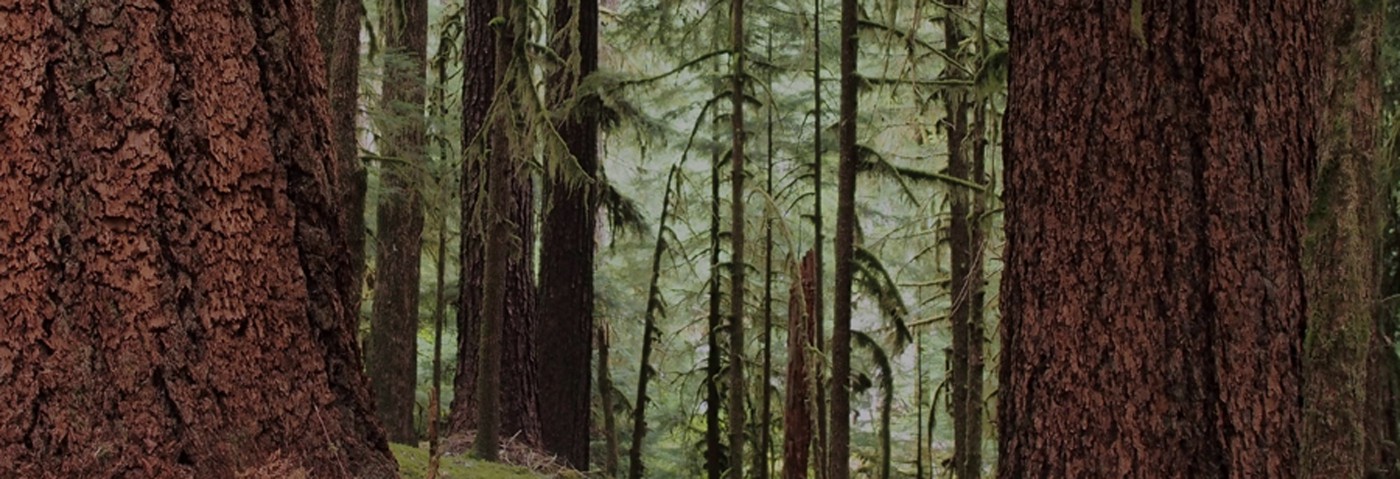
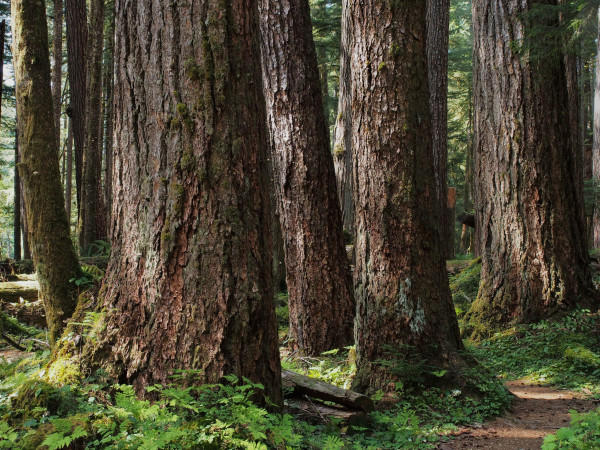
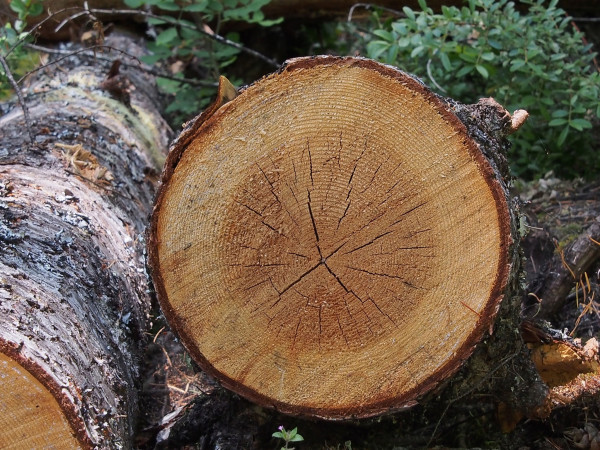
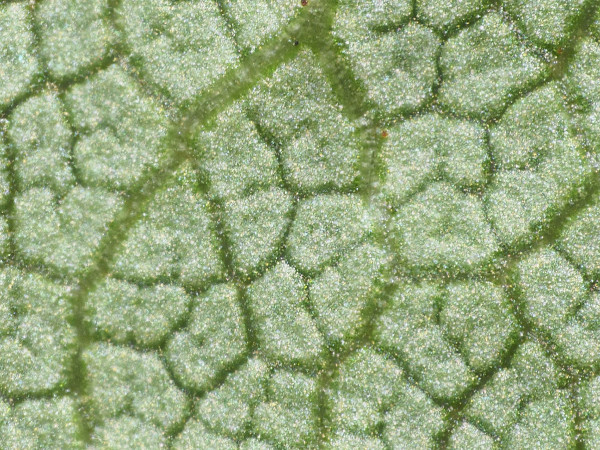
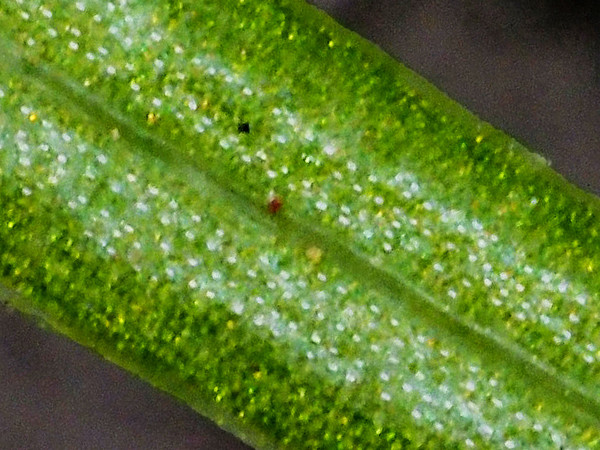
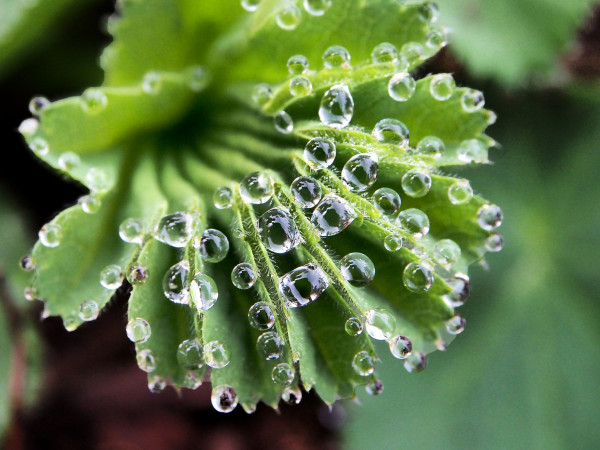
Awesome as always.
Thanks, Michael. I have to admit that these posts are a real stretch for me – after all, I am a neuroscientist, not a plant biologist! I’m glad that you are finding them of some value.
Great commentary Johnny… Tells the whole ‘drinking’ story so clearly and enjoyably! I took pretty much all the math & sciences but biology… So got it by buying texts and osmosis… Your presentation is always a fun way to dig in..! Thanks… -Marty
Thanks, Marty. I do my best, and I do love to put together pictures to help tell a story.
I have always wondered about this, because, as a matter of physics, water cannot be ‘sucked’ up a column greater than about 30 feet in height, just as (much denser) mercury cannot exceed 760 mm (30 inches) in height even when there is a complete vacuum at the top of the column. A long time ago I learned that it was capillary action that did the trick, the attraction of water molecules to the walls of a thin tube. Now I wonder if the ‘breaks’ you mentioned are just as crucial: If water ‘pools’ at various heights it can be ‘sucked up’ an additional 30 feet. In any case it is transpiration that provides the driving force: As water evaporates it creates a partial vacuum.
Yes, isn’t biology full of complexity and subtlety? As you say, what tall trees accomplish does not fit the model of sucking on a tube; neither can it be explained by root pressure generated by osmosis, or by capillary action in and of itself. The transpiration-cohesion theory, in which capillarity plays an important role that I did not address, was developed to meet this challenge. It has a history dating back to the late 19th century, and substantial experimental support; it is widely accepted though not without occasional substantive uncertainty. You might enjoy browsing through the Wikipedia article on xylem, which also addresses the role of capillarity in a nice way (https://en.wikipedia.org/wiki/Xylem#Transpirational_pull). As for cavitation, all the evidence I know of argues that it destroys rather than facilitates the upward transport of water. Finally, you might enjoy the article “Limits to Tree Height” in Nature 428, 851-854 (22 April 2004).
thank you for making transpiration inspirational; I’ll be talking to the roots this summer and feeling tubular
Yea!
The Wikipedia article on xylem/transpiration was first rate, although it didn’t discuss the tradeoffs among pore size, pore effectiveness, and mass flow. Clearly enough, smaller tube sizes can allow water to reach greater heights, but at the cost of reduced mass flow.
As for the article in Nature, I assume it is behind a paywall and I’m too lazy to go to the Wellesley College Library to get a reprint. To bad it wasn’t in Science, where I have a subscription.
Thanks again!
Another fascinating and instructive piece, Johnny. As I read, I couldn’t help thinking of my years in Vermont “sugaring.” What you refer to as “water” in the tree is, of course, a particular flavor of sap in maple trees. Right about now, in fact, the sap is beginning to run as the trees literally thaw enough for the process you describe to begin. And as the temperature fluctuates above and below freezing, the sap ebbs and flows. When it stays below freezing, the “run” ends until it warms up again. A good year will have several runs of several days at a time before the weather turns too warm in April and the sap turns “buddy,” losing its crisp taste. The last run is sometimes called the “frog run” as the spring frogs find the buckets and drown there (well, they used to until the entire industry converted to pipeline). That sap generally went to sweeten chewing tobacco–perhaps an apt fate.
What a great description, Larry! I’ve been reading a bit about how the freezing-thawing cycle might result in the force necessary to move the sap upward from the roots, and I may get to participate in a tapping demonstration at our fabulous local nature center here in Minnesota. So many wonders!
A fun and informational read! Thanks.
Glad you enjoyed it!
Dear Johnny, another great read. Your description of the process inspires me and allows me to connect more with the trees in my yard. For some reason the description helps my body to sense more the energy of the doug fir trees, which are about 180′ tall , more than I was able to before. Kinda fun and fascinating that visualizing the actual process in the tree helps my imagination become more involved and helps me feel more of a connection and at One with Nature. And that is why I enjoy your blog so much. There is nowhere else I can get that.
I have a question.Because in the NW we don’t really get much of a freeze, like this year, does the flow still happen in the conifers during the winter? I would imagine not in the deciduous trees since no leaves to provide the evaporation.
Dear Christopher, thank you so much for what you have written. Your words convey vividly the intention behind Nature’s Depths, and it is wonderfully satisfying to know that my efforts are working for you!
As for your questions: Yes, water continues to be drawn up conifers all through the temperate winter. The small change in temperature between summer and winter would have no effect that I can think of on transpiration. However, I don’t know how it works with deciduous trees while they have no leaves. I have wondered about that myself and will try to find out. Thanks for the question.
Also, Johnny, with conifers especially in NW with very little warm sun, does not seem to be enough heat to perform evaporation. Could you address that?
The evaporation of water – the escape of water molecules from a liquid state into the surrounding air – occurs at all temperatures above freezing. (Water molecules can even escape from ice; this is called sublimation.) Higher temperatures only make the process go faster. However, evaporation is slowed down as the humidity of the air over the water surface rises. With 100% relative humidity, the rate at which water molecules escape into the air is balanced by the rate at which they return, so there is an exchange of molecules between the liquid water and the air but no net evaporation. That’s why sweat does not evaporate readily on a humid day, whereas on a dry day at the same temperature it evaporates so quickly that you hardly notice it. Does this help?
John,
I enjoy your writings, great blend of science and prose (heart and soul?). Glad to be on your mailing list.
Michael
Thank you, Michael. You have highlighted exactly the intention I had when I started Nature’s Depths, to highlight the heart aspects of scientific understanding that often go unnoticed, and through carefully chosen science to help deepen the connections with the whole of nature that so many people instinctively feel. It’s wonderful to know that my efforts are affecting you in this way.
Awesome post, I loved it! I just got to know your blog and I’m reading some great articles that are very informative. Thanks
Thanks for your enthusiasm!
I was watching ‘Countryfile’ on BBC 1 yesterday (26/06/2018) evening and there was an item that showed a scientist using a device that allowed you to hear the water rising up through a large forest tree. Unfortunately I mised the very begining and have no other details.
I am not familiar with any such technique. However, it has been possible for quite a few years to listen to and identify the sounds generated by cavitation, the formation of air bubbles in a tree’s water columns that increases greatly under drought conditions. You might check it out here: https://phys.org/news/2013-04-cavitation-noise-trees.html. Also, there is a wonderful new book called The Songs of Trees. Read about it here: https://www.pri.org/stories/2017-05-19/yes-tree-forest-does-make-sound-have-listen
Since transpiration causes water molecules to evaporate into the atmosphere, one should be able to place a “shower cap” around the top of the tree, capture the evaporated water molecules, condense them to liquid water, then let the water run down a tube by gravity and generate electricity, as is done with hydroelectric power plants. This would be perpetual motion. Something is wrong with these water rising theories. It takes energy to lift water against gravity.
Yes, it does indeed take energy to lift water. This energy comes from the Sun, which provides enough heat to generate transpiration. I doubt that it would be feasible to use your proposed scheme to actually generate electricity, but it would not constitute a perpetual motion machine. Rather, it would be analogous to collecting rain water in a reservoir and using its downward flow due to gravity to drive a turbine. The rain condensed from evaporated water vapor, and the evaporation was driven by solar energy. Right?
I enjoyed your explanation here. Does this process cause the tree canopy of very tall trees to sway at the peak of daily heat? I.E. the tree is creating branch sway/leaf flutter?
I live in NE Georiga and I notice this swaying with 70-80 ft trees in my back yard: the species are tulip poplar and winged elm. I have 100 ft. loblolly pines nearby but haven’t observed this movement with it.
Many thanks, Teresa! I do not know the answer to your question, but here are couple consequences of transpiration that might be relevant. First, the amount of water that is released into the air by a forest can be very substantial. For example, under appropriate lighting conditions you can see a mist hovering over the Cascade Mountains of Washington even on a clear morning. Most of the water in that mist comes from transpiration. This is also true in the Amazon basin, and here there is an amazing and rather well documented phenomenon that might be relevant to your swaying trees. The transpiration of the trees in the Amazonian forest actually drives the winds that come inland from over the Atlantic Ocean, bearing with them the water that comes down and supports that forest. When there is massive deforestation, one of the consequences can be a diminution of those winds and an actual drying out of the forest. The reverse of this phenomenon has also been seen. There are areas in the Indian state of Rajasthan that are even drier now than they once were because local scrub forests have been cut down over the years. In several such areas, local folks have restored catchment ponds that used to hold rain water that falls during the monsoon. They have used that water to plant trees. And lo and behold, once even modest young forests have become established, the rains have increased. Once again, transpiration has generated winds that bring moisture. And of course, when there are winds, the trees sway. So, it may well be that the answer to your question is yes! Please remember that this is speculation on my part, not a firm answer based on evidence. Still . . . . . !